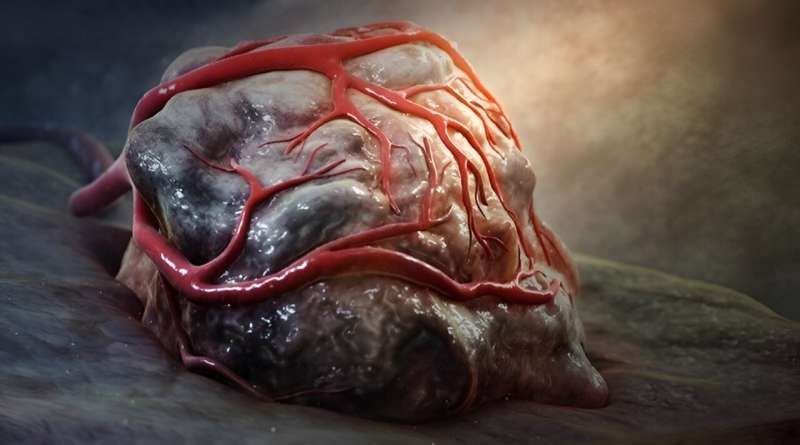This article has been reviewed according to Science X's editorial process and policies. Editors have highlighted the following attributes while ensuring the content's credibility:
fact-checked
proofread
Valuable insights into the development of new anti-angiogenic drugs

Most tumors release various signaling molecules to support their incessant growth, invasion, and metastasis. Some of these molecules, known as tumor angiogenic factors (TAF), are able to stimulate the formation of new blood vessels, which is crucial for the growth of tumors. Blocking the function of TAFs by chemical or biological molecules has been shown to shrink tumors or make them dormant, suggesting the potential of anti-angiogenic agents for effective treatment of cancers.
The first anti-angiogenic drug (AAD), which successfully inhibits the formation of new blood vessels and therefore suppresses the growth of tumor, was approved for clinical use by the US Food and Drug Administration (US-FDA) over two decades ago. At the time of this writing, numerous AADs have received clinical approval for treatment of various cancers in human patients. However, AADs in general have limited clinical benefits as anticancer drugs, even after two decades of clinical use.
A new review published in the Chinese Medical Journal on July 25, 2024, discusses new ways of employing AADs in cancer treatment to improve their clinical efficacy and recommends some methods to achieve this.
"In some tumor models, tumor suppression of over 80–90% can be achieved with a single anti-angiogenic agent. The impressive effects of anti-angiogenic monotherapy make this an attractive potential therapeutic approach," explains the author.
Currently, most of the clinically available AADs work by blocking the binding of a key angiogenic factor called vascular endothelial growth factor (VEGF) to its receptor (endothelial growth factor or VEGFR). While these anti-VEGF drugs have shown promise in treating some types of cancers, they have relatively low efficacy in the case of other types of cancer.
Explaining this further, the author says, "Clinically, limited therapeutic benefits have been observed following anti-VEGF-based monotherapy in most cancer types, with the exception of clear cell renal cell carcinoma, in which bevacizumab monotherapy significantly improves progression-free survival and overall survival."
In this review, the authors point to several knowledge gaps that could be impeding clinical adoption of anti-VEGF drugs. Hence, they have called for a better understanding of the differences between human and animal models used in anti-VEGF drug testing to improve the translation of results from the lab to human trials.
The researchers also recommend a more comprehensive examination of the interaction between AADs and other existing anticancer therapies, like chemotherapy and immunotherapy, to prevent detrimental interferences and to develop new ways of incorporating anti-VEGF drugs into existing cancer therapies.
Since tumor angiogenic pathways are intricately associated with each other, the researchers also note that specific combinations of AADs may be more beneficial for cancer treatment compared to their monotherapies.
Highlighting further, the author says, "As VEGF expression levels are always higher in tumors than in adjacent healthy tissues, targeting the VEGF-VEGFR pathway is an obvious approach for the suppression of tumor angiogenesis. Non-VEGF angiogenic factors and cytokines contribute to anti-VEGF drug resistance during treatment. Therefore, drugs that block non-VEGF angiogenic pathways should be used in combination with anti-VEGF drugs."
Furthermore, the researchers caution against using combinations of AADs with certain drugs that block non-angiogenic pathways, such as tyrosine kinase inhibitors (TKIs) which work by preventing the growth and multiplication of tumor cells.
Explaining this further, the author says, "Clinical experience with anti-angiogenic TKIs that simultaneously block several signaling pathways, including the VEGF pathway, shows that these multi-target AADs may not necessarily be more effective in cancer therapy than anti-VEGF single-target drugs."
Finally, the researchers recommend considering factors such as tumor mutations, type of tumor microenvironment, and patient profile into consideration while deciding the optimal strategy for cancer treatment involving AADs.
"Perhaps, genetic mutations in cancer cells and the constitution of the tumor microenvironment collectively determine the optimal AAD combination. Similarly, an in-depth analysis of the cellular and molecular components of the tumor microenvironment will likely provide important clues for the selection of potentially effective AADs and potentially responsive cancer patients," concludes the author.
More information: Ziheng Guo et al, Tumor angiogenesis and anti-angiogenic therapy, Chinese Medical Journal (2024). DOI: 10.1097/CM9.0000000000003231




















